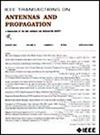Electronically Reconfigurable Reflectarray Antennas Using 2-bit Phase Shift Unit Cells Embedded With Reflecting Circuits
IF 4.6
1区 计算机科学
Q1 ENGINEERING, ELECTRICAL & ELECTRONIC
引用次数: 0
Abstract
We present an electronically reconfigurable reflectarray capable of performing 2-D beam-scanning. This reflectarray uses an electronically reconfigurable unit cell, consisting of an antenna and a reflecting circuit that provides a 2-bit reflection phase shift. A general method for designing this unit cell is presented that can be adapted for use with different antenna types and reflecting circuit designs according to the user’s requirements. The unit cell used to verify this approach consists of an E-shaped patch located above a ground plane and a reflecting circuit located underneath it. The reflecting circuit uses three p-i-n diodes to provide four phase shift states. Each unit cell uses three dc bias lines to switch the p-i-n diodes on and off. The p-i-n diodes are the only lumped element components used in each unit cell, which reduces the design and assembly complexity when constructing large-scale reflectarrays. Simulation results demonstrate that the unit cells can achieve less than 2.2-dB loss and a phase error under 35° in the frequency range of 5.6–6.2 GHz. This unit cell was used to design a 208-element reconfigurable reflectarray prototype with a circular aperture diameter of 40 cm (使用嵌入反射电路的2位相移单元的电子可重构反射天线
我们提出了一种能够进行二维波束扫描的电子可重构反射射线。该反射阵列采用电子可重构单元,由天线和提供2位反射相移的反射电路组成。提出了一种设计该单元格的通用方法,该方法可以适应不同天线类型的使用,并根据用户的要求进行反射电路设计。用于验证这种方法的单元由位于接地面上方的e形贴片和位于其下方的反射电路组成。反射电路使用三个p-i-n二极管提供四种相移状态。每个单元使用三条直流偏置线来开关p-i-n二极管。p-i-n二极管是每个单元电池中唯一使用的集总元件,这在构建大规模反射镜时降低了设计和组装的复杂性。仿真结果表明,在5.6 ~ 6.2 GHz的频率范围内,该单元单元的损耗小于2.2 db,相位误差小于35°。该单元电池被用于设计一个具有208个单元的可重构反射阵列原型,其圆孔径直径为40 cm ($8\lambda $ at 6.0 GHz)。设计、制作、集成了反射镜样机及其数字控制电路,并进行了实验表征。该系统能够控制每个p-i-n二极管的状态,以执行电子束转向。可重构反射天线的测量结果表明,它能够在5.6至6.2 GHz的工作带宽上,在±60°的扫描范围内进行二维波束扫描。孔径效率为34.2%。
本文章由计算机程序翻译,如有差异,请以英文原文为准。
求助全文
约1分钟内获得全文
求助全文
来源期刊
CiteScore
10.40
自引率
28.10%
发文量
968
审稿时长
4.7 months
期刊介绍:
IEEE Transactions on Antennas and Propagation includes theoretical and experimental advances in antennas, including design and development, and in the propagation of electromagnetic waves, including scattering, diffraction, and interaction with continuous media; and applications pertaining to antennas and propagation, such as remote sensing, applied optics, and millimeter and submillimeter wave techniques

 求助内容:
求助内容: 应助结果提醒方式:
应助结果提醒方式:


